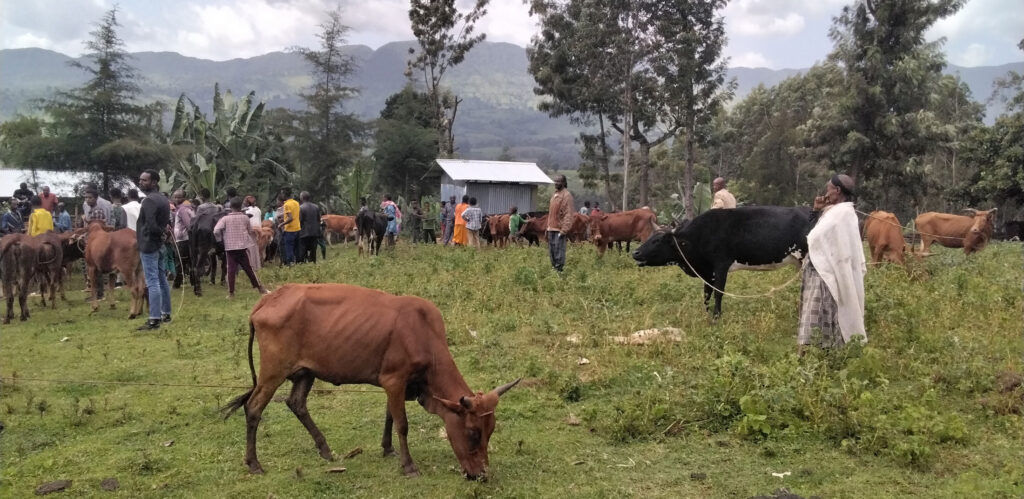Agricultural livelihoods predominate among the rural population of Ethiopia to such an extent that agriculture makes up 32.5% of the country’s GDP (2020/21) and accounts for 63.5% of employment (2021). Despite the importance of the sector, agriculture confronts a number of challenges. In recent decades the development of yield-enhancing technologies with the potential to improve smallholders’ livelihoods has excited development practitioners, yet many of these innovations have not had the desired impact. A critical challenge for smallholder farmers is limited access to improved technologies and information. Digital and other technological innovations have created new opportunities to provide and deliver tailored information to farmers. To exploit this opportunity, Precision Development (PxD) is implementing a model to deliver personalized agricultural advice to farmers via their mobile phones.

In October 2019, PxD Ethiopia and Digital Green launched a five-year project entitled Digital Agricultural Advisory Services (DAAS) with support from the Bill & Melinda Gates Foundation and the United Kingdom’s Foreign, Commonwealth & Development Office (FCDO). The project aims to enhance the digital ecosystem of Ethiopia by strengthening existing digital advisory services, establish a new technology platform (FarmStack) to enable actors to more seamlessly share data, and – through the platform – catalyze the activities of actors across the ecosystem.
PxD alleviates information poverty by delivering personalized information to users. By providing actionable information and advice, in the right way and at the right time, we enable farmers to make informed decisions that enhance their livelihoods and productivity. In the dairy cattle context, the optimal realization of this vision would be to provide customized advisory services targeting each farmer and each cow. Obtaining data and integrating data optimally are critical to achieving these ends.
Given the availability of datasets from multiple initiatives in the country, and the potential of data integration underpinning value-added services, the project targeted the development of exemplary use cases. These use cases showcase the value of data and content integration, and highlight their potential to enhance the value of existing agricultural advisory services. To identify the most promising interventions, we mapped existing data and content ecosystems in the country and explored opportunities in the Ethiopian dairy sector for creating value-added services through more efficient data sharing, data integration, big data analytics, and targeted service delivery. The team identified key stakeholders, content gaps, and potential value addition through data and content integration.
The types of data we uncovered through data ecosystem mapping include farmer profiles, plot and herd characteristics, feed resources, farming, and non-farming activities, crop and livestock commodities, gender roles, technology adoption, and issues with performance and capacity. Farm and farmer profile data help inform precise development interventions and, by leveraging data from research projects, help service providers make more informed decisions. For example, PxD started disseminating timely messages to dairy farmers to use Artificial Insemination (AI) services when the service is available and at the time when the cow comes to heat. Using ecosystem mapping data, we identified a set of interventions that have the potential to catalyze significant improvements in the dairy sector. These include more efficient breeding and breed improvement, improved feed and feeding management, improved dairy cattle health services, and more effective marketing of dairies and dairy products.
The team was particularly motivated to improve the provision of effective AI services to increase the proportion of crossbred dairy cattle in the country. Currently, crossbreed cattle only account for 2% of the national herd. Increasing the share of crossbred cattle, and reducing the share of indigenous breeds, can improve dairy productivity. However, there are challenges undermining efficient and effective AI service provision in the country, and these challenges contribute to the low level of success of AI service provision. Challenges include capacity gaps among AI technicians, failure to take cows in heat for timely insemination, and unintended mating. Significant problems are similarly evident in feed and feeding management. After identifying gaps in optimal feed utilization for improved dairy productivity, PxD developed use cases for improved feed and feeding management.
PxD is collaborating with the Ethiopian Agricultural Transformation Institute, the Ministry of Agriculture, the Public-Private Partnership for Artificial Insemination Delivery, the Livestock Development Institute, the Netherlands Development Organization, and others, to develop use cases that aim to provide value-added services to farmers, AI technicians, and development agents. By leveraging a human-centered design approach, PxD Ethiopia has developed content to improve the management of AI, cow pregnancy and lactation, and calf rearing. We have disseminated customized advisory content to farmers and AI technicians through Interactive Voice Response (IVR) push calls.
The feedback that we have received from farmers and AI technicians has been encouraging, with a significant number of farm households reporting that they are adopting improved dairy practices. Two rounds of monitoring data confirm the contribution that data-, content-, and service-integration have made to the value-added services created by the project.
In the two-and-a-half years since its inception, the IVR component of the DAAS project has made significant progress. Today we reach 400,000 farmers via the inbound and outbound channels. By the end of 2024, we aim to scale the advisory, which is focused on the most promising practices, to 2.5 million Ethiopian farmers. Because of efficient data sharing and improved analytical capacity, customized and targeted interventions are benefiting farmers who provide information to development partners. Similarly, development partners are leveraging the existing data sources to design interventions that aim to help farmers and reduce redundancy of efforts. Overall, through efficient data sharing, farmers will benefit from the reduced cost of data collection and from targeted interventions.